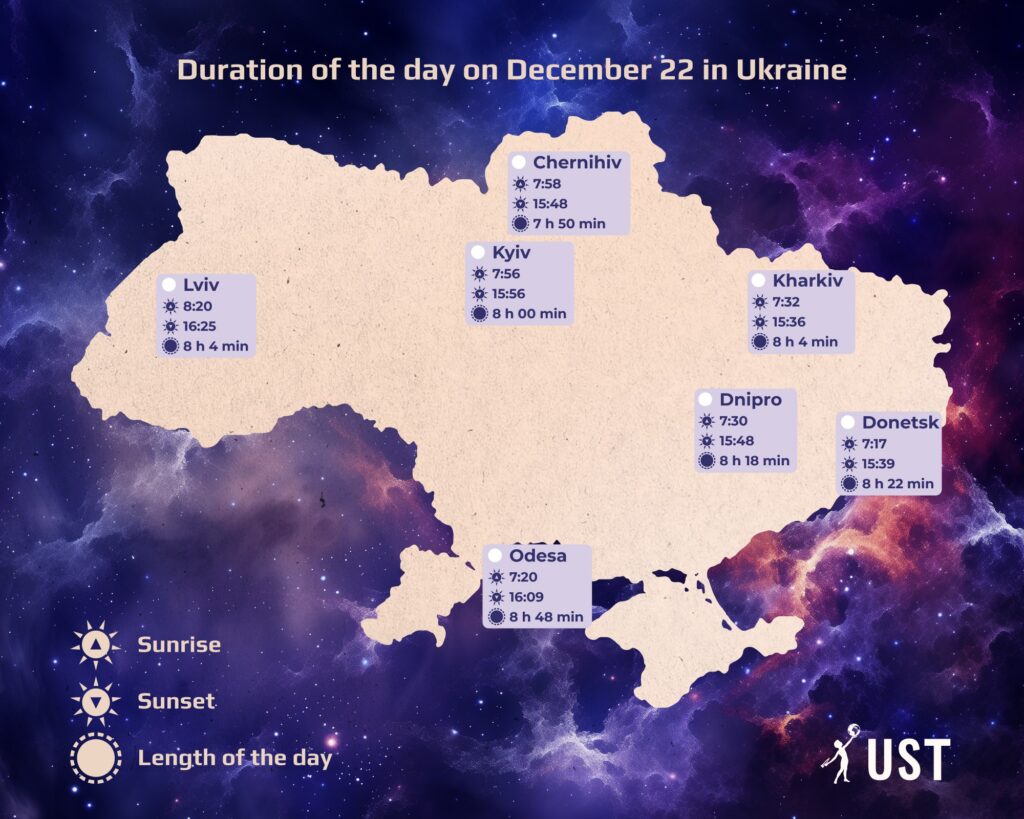On December 22, the solstice will take place, and it will be winter in the Northern Hemisphere. For Ukraine, this means the onset of the shortest day. However, we are not talking about the total length of the day but only about the duration of its light part. Here are some interesting facts about this event.

1. Why will this day be the shortest?
The reason the duration of the daylight part of the day increases and decreases during the year is that the axis of rotation of our planet is not quite perpendicular to the plane of the ecliptic. The angle between them is 66°34′.
The position of the axis of rotation remains unchanged throughout the year, as a result of which our planet tilts towards the sun in the southern and northern hemispheres. And on December 21–22, the Earth passes the point of the orbit at which the North Pole appears to be tilted most strongly to the side directly opposite to the direction where light and heat are waiting for it.
2. Will the length of the day be the same all over Ukraine?
In Kyiv, on December 22, the daylight duration will be almost exactly 8 hours. However, Ukraine is large enough for this value to vary significantly at different latitudes on the same day. In the north, in Chernihiv, the duration of the light part of the day on this day will be 7 hours and 50 minutes, but in Sevastopol, in the very south of Crimea, it will be 8 hours and 48 minutes.
As for the difference between East and West, the Sun will be above the horizon at the same time for points lying at the same latitude. It’s just that in the east of Ukraine, it will rise and set earlier, and in the west — later. For example, in Luhansk, the day will last from 7:13 a.m. to 3:30 p.m., and in Lviv — from 8:19 a.m. to 4:25 p.m. UTC time.
3. Are there places on Earth where the length of the day does not change throughout the year?
In general, the length of daylight on December 22nd will depend on which parallel you are on. The further north you go, the shorter the day will become until you cross the Arctic Circle, beyond which the Sun will not rise at all on that day (more precisely, the center of the solar disk will not cross the line of the mathematical horizon).
But if you move south, the duration of the daylight part of the day will increase. At the equator, it will be exactly 12 hours (taking into account atmospheric refraction — about 5 minutes more). On this line, the length of daylight does not change at all, and the Sun always rises perpendicular to the horizon.
4. Where will be the longest day on December 22nd?
In the Southern Hemisphere, the solstice on December 22, on the contrary, will be summer. The further away we are from the equator, the light part of the day will become longer. Akademik Vernadsky station on the Antarctic Peninsula is a tiny piece of Ukraine, where this day will be the longest of the year. It will last for 22 hours, 24 minutes and 42 seconds.
The night before it will be so short that the real darkness will not come at all. However, the Akademik Vernadsky is still not located beyond the Antarctic Circle. At the Amundsen-Scott station (at the South Pole), the sun will not set at all on this day, making a full turn at a constant altitude of 23°26′ above the horizon.

5. How fast will the day start to increase after the solstice?
If we return to the dark winter Ukraine, then it would be logical to conclude that if this day is the shortest of the year, after it the duration of the light part of the day will begin to increase. This is indeed the case, although these changes will be quite slow.
The next day, December 23rd, will be just a few seconds longer. During the week, the duration of the light part of the day in Kyiv will be 8 hours and 3 minutes. In two weeks, which is after the New Year, the Sun will shine in the sky for 8 hours and 10 minutes. And in a month, the time between sunrise and sunset of our luminary over the horizon will reach 8 hours, 48 minutes.
Follow us on Twitter to get the most interesting space news in time
https://twitter.com/ust_magazine


